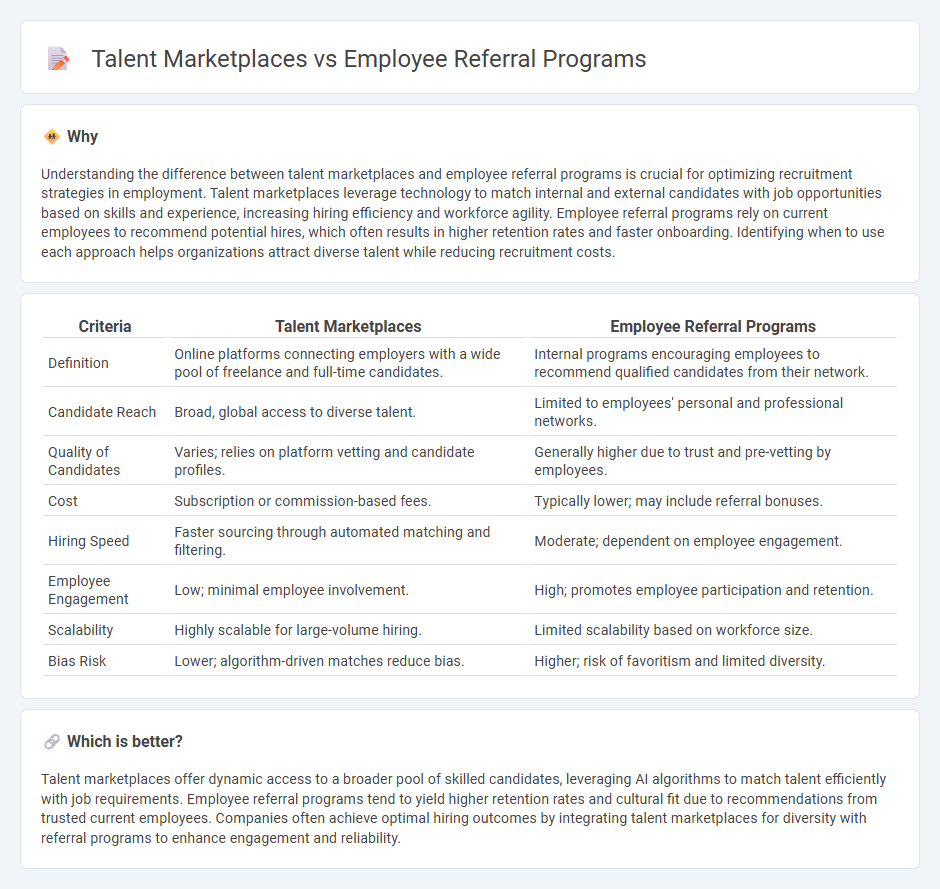
Talent marketplaces leverage digital platforms to connect employers with a diverse pool of qualified candidates, enhancing hiring efficiency and broadening access to specialized skills. Employee referral programs capitalize on existing staff networks to identify trusted candidates, often resulting in faster onboarding and higher retention rates. Explore how these recruitment strategies can transform your hiring process and optimize workforce quality.
Why it is important
Understanding the difference between talent marketplaces and employee referral programs is crucial for optimizing recruitment strategies in employment. Talent marketplaces leverage technology to match internal and external candidates with job opportunities based on skills and experience, increasing hiring efficiency and workforce agility. Employee referral programs rely on current employees to recommend potential hires, which often results in higher retention rates and faster onboarding. Identifying when to use each approach helps organizations attract diverse talent while reducing recruitment costs.
Comparison Table
| Criteria | Talent Marketplaces | Employee Referral Programs |
|---|---|---|
| Definition | Online platforms connecting employers with a wide pool of freelance and full-time candidates. | Internal programs encouraging employees to recommend qualified candidates from their network. |
| Candidate Reach | Broad, global access to diverse talent. | Limited to employees' personal and professional networks. |
| Quality of Candidates | Varies; relies on platform vetting and candidate profiles. | Generally higher due to trust and pre-vetting by employees. |
| Cost | Subscription or commission-based fees. | Typically lower; may include referral bonuses. |
| Hiring Speed | Faster sourcing through automated matching and filtering. | Moderate; dependent on employee engagement. |
| Employee Engagement | Low; minimal employee involvement. | High; promotes employee participation and retention. |
| Scalability | Highly scalable for large-volume hiring. | Limited scalability based on workforce size. |
| Bias Risk | Lower; algorithm-driven matches reduce bias. | Higher; risk of favoritism and limited diversity. |
Which is better?
Talent marketplaces offer dynamic access to a broader pool of skilled candidates, leveraging AI algorithms to match talent efficiently with job requirements. Employee referral programs tend to yield higher retention rates and cultural fit due to recommendations from trusted current employees. Companies often achieve optimal hiring outcomes by integrating talent marketplaces for diversity with referral programs to enhance engagement and reliability.
Connection
Talent marketplaces and employee referral programs are connected through their focus on optimizing recruitment efficiency and quality of hire. Talent marketplaces leverage employee networks, enhancing referral programs by expanding access to qualified candidates and streamlining candidate matching using AI-driven tools. This integration significantly reduces time-to-hire and improves employee retention rates by sourcing culturally aligned talent.
Key Terms
Internal Networking
Employee referral programs leverage trusted networks within an organization to identify high-quality candidates, promoting faster hiring cycles and improved retention rates. Talent marketplaces expand internal networking by enabling employees to explore cross-departmental opportunities, fostering skill development and organizational agility. Explore how integrating these approaches can maximize talent utilization and drive business growth.
Talent Matching
Employee referral programs leverage existing employees' networks to identify candidates aligned with company culture, enhancing talent matching through trusted recommendations. Talent marketplaces use AI-driven algorithms and real-time data to match candidates' skills, experiences, and aspirations with open roles, optimizing fit beyond social connections. Discover how these approaches transform talent acquisition efficiency and quality by learning more about their unique matching capabilities.
Incentive Structures
Employee referral programs typically offer direct monetary bonuses or non-monetary rewards such as gift cards or extra vacation days to incentivize employees for successful hires. Talent marketplaces use gamified incentives, reputation points, or tiered rewards to motivate internal talent to engage with project-based opportunities and skill development. Explore more to understand how these incentive structures impact recruitment effectiveness and employee engagement.
Source and External Links
7 Brilliant Employee Referral Programs Examples - Employee referral programs improve hiring quality and engagement by using incentives, ease of use, feedback, and recognition to encourage employees to recommend candidates from their networks.
Employee referral program: Benefits & strategies - These programs reward employees with bonuses or perks for successful hires they refer, providing benefits like higher-quality hires, faster recruitment, and lower costs while requiring clear processes and early recognition.
Why Employee Referral Programs Are a Game-Changer - Best practices include setting clear guidelines, offering meaningful incentives, effective communication, and leveraging technology to simplify submissions and track referrals for better program results.
 dowidth.com
dowidth.com